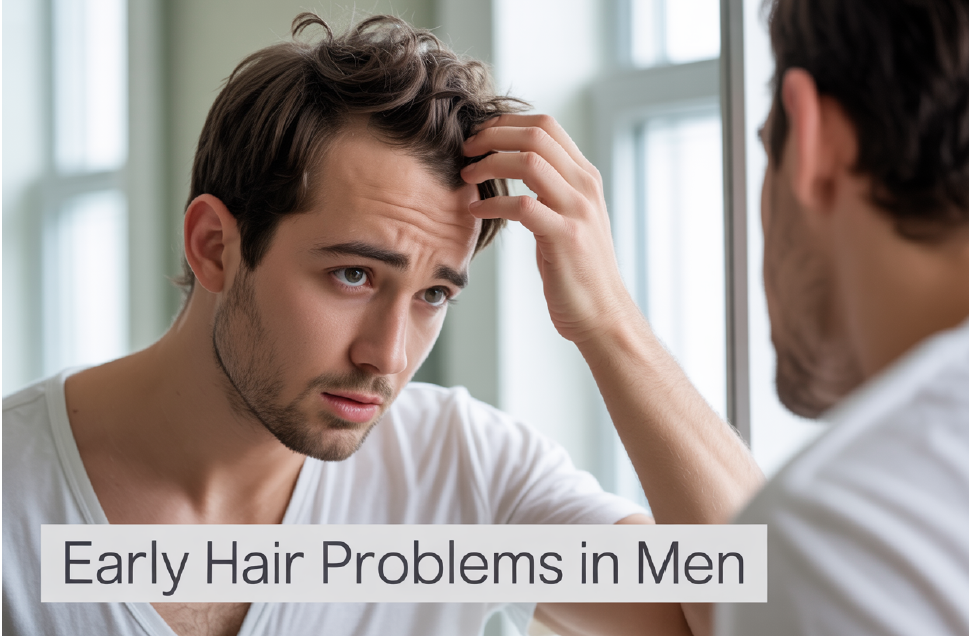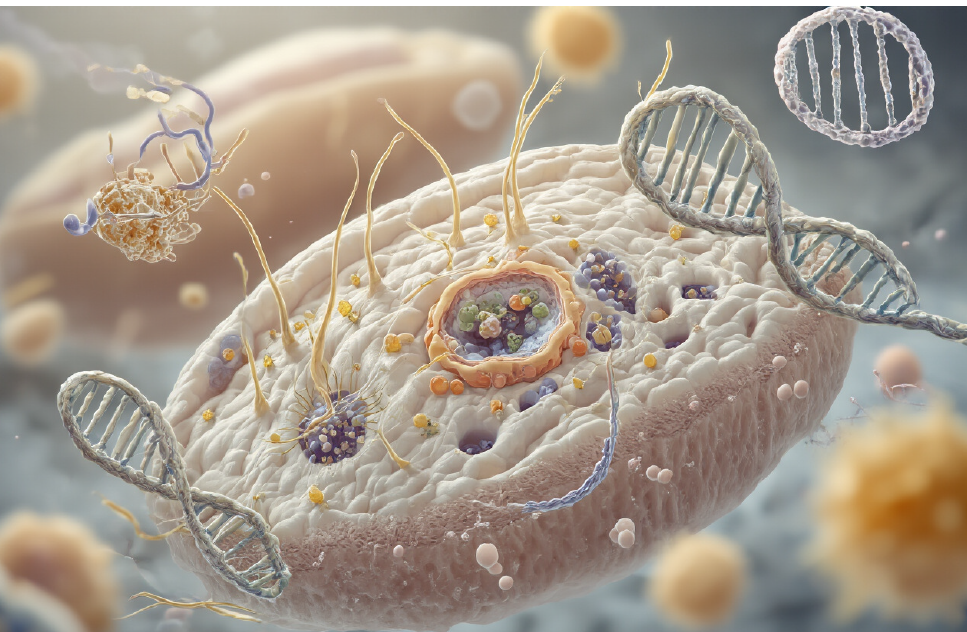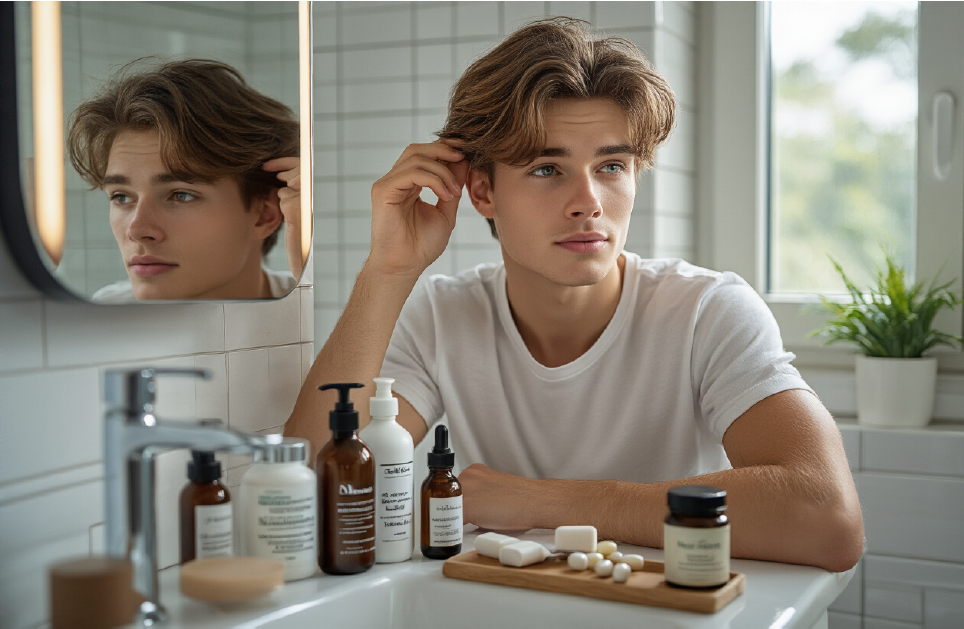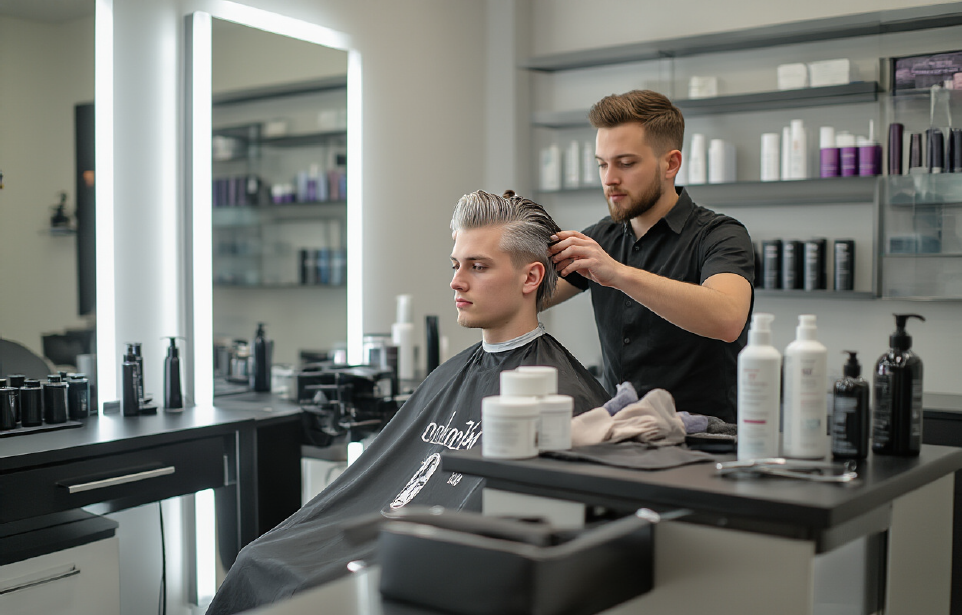WHY MEN ARE FACING THE ISSUE OF GREY
HAIR AND HAIRFALL AT A VERY EARLY AGE OF
23-24 IN TODAYS LIFE

Spotting your first gray hair or dealing with hair fall at just 23 or 24 can be pretty shocking. You’re barely
out of college, and suddenly you’re facing issues that seem like they should be decades away.
This guide is for young men who are experiencing premature gray hair in men and early hair loss at 23,
wondering if this is normal and what’s causing it to happen so early.
More guys are asking “why men get gray hair young” and dealing with male pattern baldness early 20s
than ever before. The truth is, several factors are working against your hair earlier than previous
generations experienced.
We’ll break down the main culprits behind premature graying causes – from your DNA to your daily stress
levels – and explore how things like poor nutrition and modern lifestyle choices accelerate hair fall in
young men. You’ll also learn practical prevention strategies that can help slow down these changes and
treatment options if you decide you want to take action.
The good news? Understanding what’s happening gives you the power to make informed choices about
your hair’s future.
The Science Behind Premature Graying and Hair
Loss

How Melanin Production Affects Hair Color
Hair pigmentation is fundamentally determined by melanin produced by melanocytes, which are neural
crest derivatives located within the hair follicle. Human hair contains two distinct types of melanin:
eumelanin and pheomelanin. The remarkable diversity of hair colors we observe results primarily from
the quantity and ratio of black-brown eumelanin and reddish-brown pheomelanin present in the hair
shaft.
When premature gray hair in men occurs, it’s directly linked to a breakdown in this melanin production
system. The pigmentary unit within the hair follicle becomes compromised, with melanocytes becoming
fewer in number and taking on a rounded appearance. Lightly pigmented oligodendritic melanocytes
become visible in the proximal hair bulb, indicating a failing melanogenesis process.
The transformation to gray hair primarily results from an optical phenomenon involving the reflection or
refraction of incident light, which makes the pale-yellow keratin appear white. Interestingly, gray hair
retains some color due to scattered melanosomes, while completely white hair lacks them entirely. This
explains why early hair loss at 23 is often accompanied by varying shades of gray rather than uniform
white coloration.
The Role of Hair Growth Cycles in Pigmentation
Melanogenesis in hair follicles is intrinsically synchronized with the hair growth cycle, being active
exclusively during the anagen phase while completely turned off during catagen and remaining absent
during telogen. This cyclical nature is crucial to understanding why men get gray hair young.
During the anagen phase, which typically lasts 3-5 years with monthly hair growth of approximately 1 cm,
active melanogenesis begins during early anagen. Pigmented granules are transferred to keratinocytes
as they pass through Anagen IV-VI stages. However, as hair approaches regression at the end of
anagen VI, melanocyte activity naturally decreases with dendrite retraction, resulting in less pigmented
hair shafts.
The aging process causes a marked reduction in melanocytes through autophagolysosomal
degeneration during anagen, leading to progressive pigment loss. This process is particularly
accelerated in cases of premature graying causes, where the normal hair cycle timing becomes
disrupted. Defective melanosomal transfer and melanin incontinence due to melanocyte degeneration
compound the problem, resulting in the characteristic pattern where scalp hair is affected first, followed
by facial and body hair.
Understanding Oxidative Stress and Free Radical Damage
Reactive oxygen species (ROS) play a critical role in the development of stress causing gray hair and
represent one of the most significant factors in premature graying. These harmful molecules are
generated during the normal melanogenesis process and can severely disrupt melanocyte function,
leading to oxidative stress-related melanocyte dysfunction.
Under normal circumstances, antioxidant defense mechanisms including superoxide dismutase and
catalase work to neutralize ROS. However, the decline in these protective systems with age contributes
significantly to oxidative stress accumulation. This oxidative damage affects crucial gene expression
patterns, including BCL-2, TRP-2, TRP1, MITF, and PAX3 – all essential for maintaining healthy
melanocyte function.
BCL-2 is particularly important as it regulates cell survival in oxidative environments. Reduced BCL-2
expression leads directly to melanocyte apoptosis and subsequent graying. Similarly, MITF
(Microphthalmia-associated transcription factor) is essential for melanocyte stem cell preservation, and
its deficiency results in progressive depigmentation.
External factors significantly amplify this oxidative stress burden. UV radiation induces oxidative stress
through increased ROS production, damaging melanocytes and disrupting melanin synthesis. Smoking
accelerates follicle aging via oxidative stress and DNA damage, while chronic alcoholism and
psychological stress further compound these effects. Understanding these mechanisms is crucial for
developing effective strategies to prevent nutritional deficiency hair loss and other forms of premature
graying in young men.
Lifestyle and Environmental Triggers

Chronic Stress and Cortisol Impact on Hair Follicles
Chronic stress emerges as a significant contributor to premature gray hair in men, particularly affecting
those in their early twenties. Research indicates that the physiological impact of prolonged stress creates
a cytotoxic effect of reactive oxygen species on follicular melanocytes – the cells responsible for hair
pigmentation. This oxidative stress process directly attacks the melanin-producing cells within hair
follicles, accelerating the graying process far beyond its natural timeline.
The connection between stress and premature graying becomes particularly evident when examining
family history patterns. Studies show that men with family histories of depression demonstrate
significantly higher odds of experiencing premature gray hair, with an odds ratio of 1.603. This
correlation suggests that psychological stress factors, whether genetic predisposition or environmental
triggers, play a crucial role in disrupting normal hair pigmentation processes.
Smoking and Nicotine Buildup in Hair Follicles
Interestingly, research reveals an unexpected relationship between smoking history and premature
graying in young men. Contrary to common assumptions about smoking’s harmful effects on hair health,
studies demonstrate a significant negative association between smoking history and premature gray
hair. This finding suggests that nicotine and other compounds in cigarettes may actually provide some
protective effect against early graying, though this doesn’t negate smoking’s numerous other health
risks.
The biological mechanisms behind this protective effect remain under investigation, but the statistical
significance of this negative association (P = 0.003) indicates a measurable relationship that challenges
conventional wisdom about smoking’s impact on hair pigmentation.
UV Exposure and Sun Damage to Hair Pigmentation
Ultraviolet radiation exposure represents another environmental factor contributing to premature graying,
though specific mechanisms vary by individual genetic makeup and exposure patterns. The cumulative
effect of UV damage on hair follicles compounds the oxidative stress already present from other lifestyle
factors, creating an accelerated aging process within the hair structure.
Sun exposure particularly affects the melanocyte function within hair follicles, disrupting the normal
production and distribution of melanin that gives hair its natural color. This environmental stressor works
synergistically with genetic predisposition and other lifestyle factors to manifest visible graying earlier
than genetically programmed.
Chemical and Heat Damage from Hair Products
While direct research on chemical and heat damage isn’t extensively covered in current studies, the
oxidative stress framework that drives premature graying suggests that harsh chemical treatments and
excessive heat styling could contribute to follicular damage. The same reactive oxygen species that
cause natural graying may be amplified by chemical processing and thermal stress from styling tools,
potentially accelerating the timeline for visible gray hair appearance in men experiencing early onset
graying.
Nutritional Deficiencies That Accelerate Hair
Problems

Critical Vitamins and Minerals for Hair Health
The relationship between nutritional deficiency hair loss and premature graying in young men is more
significant than many realize. Several essential nutrients directly impact melanin production and hair
follicle health, making their deficiency a critical factor in why men get gray hair young.
Iron plays a fundamental role in hair health, as it’s essential for creating hemoglobin in blood cells that
carry oxygen throughout the body. Research shows it’s not uncommon to have low iron levels when
experiencing premature hair graying. Men following restrictive diets or those with poor absorption may be
particularly susceptible. Iron-rich foods include meats, lentils, and dark leafy greens.
Copper deficiency can significantly interfere with energy production and affect blood cells and connective
tissues. This mineral is crucial because it helps the body metabolize iron and create new blood cells,
while also playing a direct role in melanin production. Sources include peanuts, almonds, lentils, beef
liver, crabmeat, and white mushrooms.
Zinc acts as a cellular protector, safeguarding cells and DNA from damage while helping the body
produce protein. Zinc deficiency may directly affect hair health and contribute to early hair loss at 23 and
premature graying causes.
Calcium extends beyond bone health, promoting nerve, heart, and muscle function. While primarily
found in dairy products like milk and yogurt, calcium deficiency has been linked to premature graying in
young adults.
Vitamin D is essential not only for bone health but also affects melanin production in hair follicles.
Research indicates that people with prematurely graying hair often have vitamin D deficiencies,
suggesting this nutrient plays a crucial role in maintaining natural hair color.
Protein Deficiency and Vegetarian Diet Risks
Now that we have covered the essential minerals, protein deficiency presents unique challenges,
particularly for men following vegetarian diets. Keratin, a specialized protein present in surface cells, is
fundamental to hair structure and pigmentation. When keratin proteins break down in hair follicles, this
leads to both hair loss and pigmentation changes.
While you cannot consume keratin directly, ensuring adequate protein intake allows the body to extract
amino acids and convert them into keratin. Men following vegetarian or vegan diets face higher risks of
protein deficiency, which can accelerate both hair fall in young men and premature graying.
The challenge intensifies because plant-based proteins often lack complete amino acid profiles
compared to animal sources. Vegetarian men in their early twenties must be particularly vigilant about
combining different protein sources to ensure they receive all essential amino acids necessary for
healthy hair follicle function.
Vitamin B-6 deficiency tends to be more prominent among people who don’t eat meat. This deficiency
can manifest through dry hair, cracked lips, and fatigue – early warning signs that may precede more
serious hair problems. Certain autoimmune and kidney conditions can also affect how the body absorbs
vitamin B-6, making supplementation potentially necessary under medical supervision.
Vitamin B12 Deficiency and Pernicious Anemia
With this in mind, Vitamin B12 deficiency represents one of the most significant nutritional factors in
premature gray hair in men. Research consistently shows that many young adults with gray hair also
have vitamin B12 deficiency, making this connection particularly relevant for men experiencing early
graying.
Researchers have specifically noted that vitamin B12 deficiencies are often concurrent with folic acid and
biotin deficiencies in people whose hair has started turning gray early. This vitamin is essential for
metabolism, DNA production, and overall energy levels – all critical processes for maintaining healthy
hair follicles and melanin production.
Vegetarians and vegans face the highest risk because vitamin B12 primarily occurs in animal products.
Men following plant-based diets in their twenties often develop deficiencies that manifest as premature
graying and hair loss. The daily vitamin B12 recommendation for most adults is 2.4 mcg, but deficient
individuals may require higher therapeutic doses.
Pernicious anemia, an autoimmune condition that prevents vitamin B12 absorption, can accelerate hair
problems regardless of dietary intake. This condition prevents the stomach from producing intrinsic
factor, a protein necessary for B12 absorption. Men with pernicious anemia often require vitamin B12
injections rather than oral supplements to address deficiency-related hair issues.
The interconnected nature of B-vitamin deficiencies means that addressing one deficiency often requires
comprehensive nutritional assessment. Vitamin B-9 (folic acid) works synergistically with B12 in amino
acid metabolism and DNA functions. When deficient in vitamin B-9, men may experience hair, skin, and
nail pigmentation changes that compound B12-related problems.
Prevention and Management Strategies

Stress Reduction Techniques and Lifestyle Changes
Now that we understand the underlying causes of premature graying and hair loss, managing stress
becomes crucial in preventing early hair problems in young men. Research reveals that oxidative
stress—an imbalance of antioxidants and free radicals in the body—is directly linked to premature
graying. Chronic stress of any kind can lead to chronic inflammation, which may shut down melaninmaking
cells while shortening the hair growth cycle.
Effective Stress Management Approaches:
Practice science-backed stress relief methods like yoga or meditation
Spend time outdoors regularly to naturally reduce stress levels
Establish consistent sleep patterns to support hair follicle health
Engage in regular physical activity to combat inflammation
Critical Lifestyle Modifications:
Smoking cessation: Smoking is a key factor in oxidative stress and is correlated with premature
graying in all age groups. The habit damages and shrinks hair follicles, accelerating both graying
and hair loss
Reduce inflammatory triggers: Limit exposure to environmental pollutants and toxins that can
stress hair follicles
Maintain regular health check-ups: Some medical conditions, including autoimmune disorders and
heart disease, may be related to premature graying
Dietary Modifications and Supplement Options
With this in mind, next, we’ll explore how dietary choices directly impact hair pigmentation and health.
What you eat can be either pro-inflammatory or anti-inflammatory, significantly affecting the cells
responsible for hair color production.
Anti-Inflammatory Diet Recommendations:
Antioxidant-rich fruits and vegetables that neutralize reactions negatively impacting pigmentproducing
cells:
Berries (blueberries, strawberries, blackberries)
Dark, leafy greens (spinach, kale)
Red grapes or red wine (in moderation)
Fresh herbs and spices
Foods to Limit:
Soda and sugar-sweetened beverages
Commercial baked goods and candy
Ultra-processed, high-fat meats like bacon, sausage, and salami
Foods high in added sugars and saturated fats
Essential Vitamins and Minerals for Hair Health:
Nutrient Food Sources Benefits
Vitamin B12 Beef liver, clams, tuna, nutritional yeast, salmon Prevents graying acceleration
Vitamin D3 Trout, salmon, mushrooms, milk, eggs Supports follicle health
Vitamin E Sunflower seeds, almonds, hazelnuts, spinach Antioxidant protection
Iron Dark leafy greens, oysters, lentils, dark chocolate Prevents hair loss
Zinc Oysters, beef, crab, pork loin, baked beans Hair growth and repair
Copper Beef liver, oysters, shiitake mushrooms Melanin production
Selenium Brazil nuts, tuna, sardines, shrimp Antioxidant support
Natural Remedies and Supplements:
Catalase-rich foods: Garlic, cabbage, sweet potato, kale, broccoli, and almonds
Ashwagandha supplements: Take with food as Indian ginseng for stress reduction
Fo-ti: Traditional Chinese medicine recommends 1,000 milligrams twice daily with food
Hair Protection from Environmental Damage
Previously, I’ve discussed internal factors, but external protection is equally important for preventing
premature graying in young men. Environmental stressors can accelerate hair aging and damage
pigment-producing cells.
Sun Protection Strategies:
Cover hair with hats or scarves when exposed to direct sunlight
Limit prolonged sun exposure, especially during peak UV hours
Use UV-protective hair products when spending extended time outdoors
Chemical and Heat Damage Prevention:
Avoid harsh treatments: Bleaching and chemical processing damage both hair strands and
pigment cells
Limit heat styling: Reduce use of curling irons and hair dryers on high heat settings
Choose gentle hair care products: Avoid harsh soaps and shampoos that strip natural oils
Proper brushing technique: Use wide-toothed combs instead of brushes, especially on wet hair
Reduce washing frequency: Over-washing can damage hair and scalp health
Environmental Toxin Protection:
Minimize exposure to pollutants and environmental toxins
Rinse hair after swimming in chlorinated pools
Protect hair from harsh weather conditions
Consider air quality when planning outdoor activities
Gentle Hair Care Routine:
Use lukewarm water instead of hot water when washing
Apply gentle massage techniques during shampooing
Allow hair to air dry when possible
Sleep on silk or satin pillowcases to reduce friction
These comprehensive prevention and management strategies work synergistically to protect against
premature graying and hair loss, addressing both internal health factors and external environmental
stressors that contribute to early hair problems in young men.
Treatment Options and Hair Coloring Solutions

Professional Salon Coloring Techniques
Now that we have covered the underlying causes and medical approaches, let’s explore professional
treatment options available for managing premature gray hair in men. Professional salon techniques
offer the most sophisticated and long-lasting solutions for those experiencing early graying at 23-24
years old.
Professional colorists utilize advanced formulations that can effectively address the unique challenges of
young men’s hair. Unlike over-the-counter products, salon-grade treatments are specifically designed to
work with different hair textures and can provide more natural-looking results that blend seamlessly with
existing pigmentation.
The key advantage of professional coloring lies in the expertise of trained colorists who can assess
individual hair conditions and recommend appropriate treatments. For men dealing with early hair loss at
23 combined with graying, professionals can create strategic coloring plans that work in conjunction with
hair restoration treatments.
Modern salon techniques include semi-permanent and permanent coloring options, with many
establishments now offering specialized services for men experiencing premature graying. These
treatments are formulated to minimize damage while providing optimal coverage, which is particularly
important for younger men whose hair may still be in relatively good condition aside from the graying
issue.
Professional treatments also offer superior longevity compared to home solutions, typically lasting 4-8
weeks depending on hair growth rate and maintenance routine. This makes them cost-effective for men
who need consistent coverage for professional or personal reasons.
Home Care and Maintenance Routines
With this in mind, proper home maintenance becomes crucial for extending the life of any coloring
treatment. The reference content emphasizes that lifestyle and diet play fundamental roles in addressing
premature graying, making home care routines essential components of comprehensive treatment plans.
Effective home maintenance starts with adopting healthier lifestyle practices that support melanin
production. Reducing alcohol and tobacco consumption significantly impacts hair health, as these
substances can interfere with the body’s natural pigmentation processes. For young men experiencing
stress causing gray hair, implementing stress management techniques at home becomes particularly
important.
Nutritional support forms another cornerstone of home care routines. Incorporating vitamin-rich foods
that support melanin production can help slow the progression of graying while supporting overall hair
health. This is especially relevant for men dealing with nutritional deficiency hair loss, where addressing
dietary gaps can provide dual benefits for both graying and hair loss concerns.
Daily hair care routines should include gentle, sulfate-free shampoos that won’t strip color-treated hair.
Many men find success with specialized shampoos designed for gray or color-treated hair, which help
maintain vibrancy between professional treatments.
Regular scalp massage and the use of targeted serums can improve circulation and potentially support
the hair follicles’ ability to produce melanin. While the research indicates that prevention is easier than
reversal, consistent home care can help maximize the effectiveness of professional treatments.
Embracing Natural Gray Hair as a Style Choice
Previously, we’ve focused on treatment and prevention options, but it’s important to acknowledge that
embracing natural gray hair has become an increasingly popular style choice among young men. The
reference content suggests that some men may find this approach both practical and aesthetically
appealing.
The decision to embrace gray hair can be particularly empowering for men who understand the science
behind their premature graying. Knowing that factors like genetics and gray hair play significant roles can
help normalize the experience and reduce anxiety about the aging process.
For men choosing this path, the focus shifts from covering gray hair to optimizing its appearance. This
involves using specialized products designed to enhance gray tones, reduce yellowing, and maintain hair
health. Silver and gray hair can appear more vibrant and healthy with proper care, making it an attractive
option for confident young men.
The styling approach also requires consideration of overall grooming and wardrobe choices. Gray hair
can create a distinguished, mature appearance that some men find professionally advantageous, even in
their early twenties. This choice eliminates the ongoing maintenance and expense associated with
coloring treatments while embracing a natural aspect of aging.
Modern grooming trends have made gray hair more socially acceptable across all age groups, with many
young men finding that their premature graying becomes a distinctive and attractive feature rather than a
concern to hide.

The emergence of gray hair and hair loss in men during their early twenties is a complex phenomenon
driven by multiple interconnected factors. While genetics remains the strongest predictor—with
individuals being 3-5 times more likely to experience premature graying if their parents did—modern
lifestyle challenges have amplified this natural process. Chronic stress, nutritional deficiencies in vital
minerals like iron, zinc, and vitamin B12, environmental pollutants, and habits like smoking all contribute
to oxidative stress that damages melanocyte cells responsible for hair pigmentation.
Understanding these causes empowers young men to take proactive steps toward hair health. While
genetic predisposition cannot be changed, adopting stress management techniques, maintaining a
balanced diet rich in essential nutrients, protecting hair from UV damage, and avoiding smoking can
significantly slow the progression. For those already experiencing premature graying or hair loss,
professional consultation can help identify underlying medical conditions and determine appropriate
treatment options. Remember, gray hair is increasingly embraced as a sign of distinction, but the choice
to treat, cover, or embrace it remains entirely personal—what matters most is maintaining overall hair
and scalp health through informed lifestyle choices.
